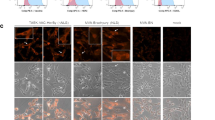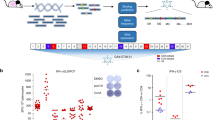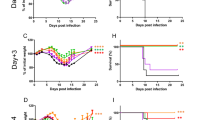Abstract
Her-2/neu is a well-characterized tumor-associated antigen, the overexpression of which in human carcinomas correlates with a poor prognosis. Here, we evaluated Her-2/neu-specific humoral and cellular immune responses in immunized monkeys after immunization with nonreplicating adenovirus (AdHM) expressing the extracellular and transmembrane domain of human Her-2/neu (HM) and/or naked DNA vaccine (pHM-hGM-CSF) expressing human granulocyte-macrophage colony-stimulating factor together with HM. Priming of monkeys with AdHM generated Her-2/neu-specific long-lasting antibody production. Furthermore, these Her-2/neu-specific antibodies produced by AdHM immunization, some of which shared epitope specificity with Herceptin, were able to induce antibody-dependent cellular cytotoxicity against Her-2-expressing target cells. Cellular immune responses were elicited in all monkeys immunized with Her-2/neu-expressing vaccine; interferon-γ was secreted when these splenocytes were restimulated with Her-2/neu-expressing autologous cells, and immunization with AdHM induced Her-2/neu-specific lymphoproliferative responses. Further, immunization with pHM-hGM-CSF before AdHM immunization noticeably enhanced cytotoxic T-lymphocyte activity. In addition, we observed no abnormalities that would indicate that the genetic vaccines had toxic effects in the immunized monkeys. Thus, we can conclude that our genetic vaccines efficiently elicited Her-2/neu-specific humoral and cellular immune responses without causing severe adverse effects in nonhuman primates and that as such they warrant further clinical investigation.
This is a preview of subscription content, access via your institution
Access options
Subscribe to this journal
Receive 12 print issues and online access
$259.00 per year
only $21.58 per issue
Buy this article
- Purchase on Springer Link
- Instant access to full article PDF
Prices may be subject to local taxes which are calculated during checkout





Similar content being viewed by others
References
Gullick WJ, Love SB, Wright C, Barnes DM, Gusterson B, Harris AL et al. c-erbB-2 protein overexpression in breast cancer is a risk factor in patients with involved and uninvolved lymph nodes. Br J Cancer 1991; 63: 434–438.
Disis ML, Calenoff E, McLaughlin G, Murphy AE, Chen W, Groner B et al. Existent T-cell and antibody immunity to HER-2/neu protein in patients with breast cancer. Cancer Res 1994; 54: 16–20.
Brossart P, Stuhler G, Flad T, Stevanovic S, Rammensee HG, Kanz L et al. Her-2/neu-derived peptides are tumor-associated antigens expressed by human renal cell and colon carcinoma lines and are recognized by in vitro induced specific cytotoxic T lymphocytes. Cancer Res 1998; 58: 732–736.
Chang SY, Lee KC, Ko SY, Ko HJ, Kang CY . Enhanced efficacy of DNA vaccination against Her-2/neu tumor antigen by genetic adjuvants. Int J Cancer 2004; 111: 86–95.
Chung Y, Kim BS, Kim YJ, Ko HJ, Ko SY, Kim DH et al. CD1d-restricted T cells license B cells to generate long-lasting cytotoxic antitumor immunity in vivo. Cancer Res 2006; 66: 6843–6850.
Lee JY, Kim DH, Chung Y, Shin SU, Kang CY . Comparison of the antitumor efficacies of Her-2/neu DNA vaccines inducing contrasting IgG immunity but comparable CTL activity in mice. Vaccine 2003; 21: 521–531.
Ko HJ, Kim YJ, Kim YS, Chang WS, Ko SY, Chang SY et al. A combination of chemoimmunotherapies can efficiently break self-tolerance and induce antitumor immunity in a tolerogenic murine tumor model. Cancer Res 2007; 67: 7477–7486.
Conry RM, Curiel DT, Strong TV, Moore SE, Allen KO, Barlow DL et al. Safety and immunogenicity of a DNA vaccine encoding carcinoembryonic antigen and hepatitis B surface antigen in colorectal carcinoma patients. Clin Cancer Res 2002; 8: 2782–2787.
Smith CL, Dunbar PR, Mirza F, Palmowski MJ, Shepherd D, Gilbert SC et al. Recombinant modified vaccinia Ankara primes functionally activated CTL specific for a melanoma tumor antigen epitope in melanoma patients with a high risk of disease recurrence. Int J Cancer 2005; 113: 259–266.
Piccart-Gebhart MJ, Procter M, Leyland-Jones B, Goldhirsch A, Untch M, Smith I et al. Trastuzumab after adjuvant chemotherapy in HER2-positive breast cancer. N Engl J Med 2005; 353: 1659–1672.
Joensuu H, Kellokumpu-Lehtinen PL, Bono P, Alanko T, Kataja V, Asola R et al. Adjuvant docetaxel or vinorelbine with or without trastuzumab for breast cancer. N Engl J Med 2006; 354: 809–820.
Dang Y, Knutson KL, Goodell V, dela Rosa C, Salazar LG, Higgins D et al. Tumor antigen-specific T-cell expansion is greatly facilitated by in vivo priming. Clin Cancer Res 2007; 13: 1883–1891.
Disis ML, Gooley TA, Rinn K, Davis D, Piepkorn M, Cheever MA et al. Generation of T-cell immunity to the HER-2/neu protein after active immunization with HER-2/neu peptide-based vaccines. J Clin Oncol 2002; 20: 2624–2632.
Park JW, Melisko ME, Esserman LJ, Jones LA, Wollan JB, Sims R . Treatment with autologous antigen-presenting cells activated with the HER-2 based antigen Lapuleucel-T: results of a phase I study in immunologic and clinical activity in HER-2 overexpressing breast cancer. J Clin Oncol 2007; 25: 3680–3687.
Reilly RT, Gottlieb MB, Ercolini AM, Machiels JP, Kane CE, Okoye FI et al. HER-2/neu is a tumor rejection target in tolerized HER-2/neu transgenic mice. Cancer Res 2000; 60: 3569–3576.
Pupa SM, Iezzi M, Di Carlo E, Invernizzi A, Cavallo F, Meazza R et al. Inhibition of mammary carcinoma development in HER-2/neu transgenic mice through induction of autoimmunity by xenogeneic DNA vaccination. Cancer Res 2005; 65: 1071–1078.
Gallo P, Dharmapuri S, Nuzzo M, Maldini D, Cipriani B, Forni G et al. Adenovirus vaccination against neu oncogene exerts long-term protection from tumorigenesis in BALB/neuT transgenic mice. Int J Cancer 2007; 120: 574–584.
Gurunathan S, Klinman DM, Seder RA . DNA vaccines: immunology, application, and optimization. Annu Rev Immunol 2000; 18: 927–974.
Aurisicchio L, Mennuni C, Giannetti P, Calvaruso F, Nuzzo M, Cipriani B et al. Immunogenicity and safety of a DNA prime/adenovirus boost vaccine against rhesus CEA in nonhuman primates. Int J Cancer 2007; 120: 2290–2300.
Bronte V . Genetic vaccination for the active immunotherapy of cancer. Curr Gene Ther 2001; 1: 53–100.
Kim JJ, Yang JS, Nottingham LK, Tang W, Dang K, Manson KH et al. Induction of immune responses and safety profiles in rhesus macaques immunized with a DNA vaccine expressing human prostate specific antigen. Oncogene 2001; 20: 4497–4506.
Conry RM, White SA, Fultz PN, Khazaeli MB, Strong TV, Allen KO et al. Polynucleotide immunization of nonhuman primates against carcinoembryonic antigen. Clin Cancer Res 1998; 4: 2903–2912.
Wolchok JD, Gregor PD, Nordquist LT, Slovin SF, Scher HI . DNA vaccines: an active immunization strategy for prostate cancer. Semin Oncol 2003; 30: 659–666.
Koizumi N, Yamaguchi T, Kawabata K, Sakurai F, Sasaki T, Watanabe Y et al. Fiber-modified adenovirus vectors decrease liver toxicity through reduced IL-6 production. J Immunol 2007; 178: 1767–1773.
Shayakhmetov DM, Gaggar A, Ni S, Li ZY, Lieber A . Adenovirus binding to blood factors results in liver cell infection and hepatotoxicity. J Virol 2005; 79: 7478–7491.
Ryan MH, Bristol JA, McDuffie E, Abrams SI . Regression of extensive pulmonary metastases in mice by adoptive transfer of antigen-specific CD8(+) CTL reactive against tumor cells expressing a naturally occurring rejection epitope. J Immunol 2001; 167: 4286–4292.
Dudley ME, Rosenberg SA . Adoptive-cell-transfer therapy for the treatment of patients with cancer. Nat Rev Cancer 2003; 3: 666–675.
Knutson KL, Schiffman K, Cheever MA, Disis ML . Immunization of cancer patients with a HER-2/neu, HLA-A2 peptide, p369-377, results in short-lived peptide-specific immunity. Clin Cancer Res 2002; 8: 1014–1018.
Hueman MT, Dehqanzada ZA, Novak TE, Gurney JM, Woll MM, Ryan GB et al. Phase I clinical trial of a HER-2/neu peptide (E75) vaccine for the prevention of prostate-specific antigen recurrence in high-risk prostate cancer patients. Clin Cancer Res 2005; 11: 7470–7479.
Sun Q, Burton RL, Dai LJ, Britt WJ, Lucas KG . B lymphoblastoid cell lines as efficient APC to elicit CD8+ T cell responses against a cytomegalovirus antigen. J Immunol 2000; 165: 4105–4111.
Youde SJ, McCarthy CM, Thomas KJ, Smith KL, Man S . Cross-typic specificity and immunotherapeutic potential of a human HPV16 E7-specific CTL line. Int J Cancer 2005; 114: 606–612.
Kusakabe K, Xin KQ, Katoh H, Sumino K, Hagiwara E, Kawamoto S et al. The timing of GM-CSF expression plasmid administration influences the Th1/Th2 response induced by an HIV-1-specific DNA vaccine. J Immunol 2000; 164: 3102–3111.
Chang DZ, Lomazow W, Joy Somberg C, Stan R, Perales MA . Granulocyte-macrophage colony stimulating factor: an adjuvant for cancer vaccines. Hematology 2004; 9: 207–215.
Serafini P, Carbley R, Noonan KA, Tan G, Bronte V, Borrello I . High-dose granulocyte-macrophage colony-stimulating factor-producing vaccines impair the immune response through the recruitment of myeloid suppressor cells. Cancer Res 2004; 64: 6337–6343.
Queen MM, Ryan RE, Holzer RG, Keller-Peck CR, Jorcyk CL . Breast cancer cells stimulate neutrophils to produce oncostatin M: potential implications for tumor progression. Cancer Res 2005; 65: 8896–8904.
Park BK, Zhang H, Zeng Q, Dai J, Keller ET, Giordano T et al. NF-kappaB in breast cancer cells promotes osteolytic bone metastasis by inducing osteoclastogenesis via GM-CSF. Nat Med 2007; 13: 62–69.
Dranoff G . Cytokines in cancer pathogenesis and cancer therapy. Nat Rev Cancer 2004; 4: 11–22.
Filipazzi P, Valenti R, Huber V, Pilla L, Canese P, Iero M et al. Identification of a new subset of myeloid suppressor cells in peripheral blood of melanoma patients with modulation by a granulocyte-macrophage colony-stimulation factor-based antitumor vaccine. J Clin Oncol 2007; 25: 2546–2553.
de Korte MA, de Vries EG, Lub-de Hooge MN, Jager PL, Gietema JA, van der Graaf WT et al. Indium-trastuzumab visualises myocardial human epidermal growth factor receptor 2 expression shortly after anthracycline treatment but not during heart failure: a clue to uncover the mechanisms of trastuzumab-related cardiotoxicity. Eur J Cancer 2007; 43: 2046–2051.
Lutsiak ME, Semnani RT, De Pascalis R, Kashmiri SV, Schlom J, Sabzevari H . Inhibition of CD4(+)25+ T regulatory cell function implicated in enhanced immune response by low-dose cyclophosphamide. Blood 2005; 105: 2862–2868.
Miyake S, Makimura M, Kanegae Y, Harada S, Sato Y, Takamori K et al. Efficient generation of recombinant adenoviruses using adenovirus DNA-terminal protein complex and a cosmid bearing the full-length virus genome. Proc Natl Acad Sci USA 1996; 93: 1320–1324.
Gallo P, Dharmapuri S, Nuzzo M, Maldini D, Iezzi M, Cavallo F et al. Xenogeneic immunization in mice using HER2 DNA delivered by an adenoviral vector. Int J Cancer 2005; 113: 67–77.
Acknowledgements
We thank Dr Norman L Letvin (Harvard Medical School, Beth Israel Deaconess Medical Center, Boston, MA, USA) for the generous gift of S594 cell line.
Author information
Authors and Affiliations
Corresponding author
Additional information
Supplementary Information accompanies the paper on Gene Therapy website (http://www.nature.com/gt)
Rights and permissions
About this article
Cite this article
Ko, HJ., Kim, YJ., Kim, YS. et al. Immunogenicity and safety profiles of genetic vaccines against human Her-2/neu in cynomolgus monkeys. Gene Ther 15, 1351–1360 (2008). https://doi.org/10.1038/gt.2008.81
Received:
Revised:
Accepted:
Published:
Issue Date:
DOI: https://doi.org/10.1038/gt.2008.81
Keywords
This article is cited by
-
A phase 1 study of a heterologous prime-boost vaccination involving a truncated HER2 sequence in patients with HER2-expressing breast cancer
Molecular Therapy - Methods & Clinical Development (2015)
-
Enhanced antitumor immunotherapeutic effect of B-cell-based vaccine transduced with modified adenoviral vector containing type 35 fiber structures
Gene Therapy (2014)



